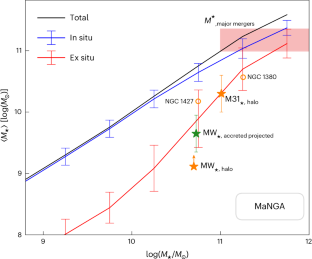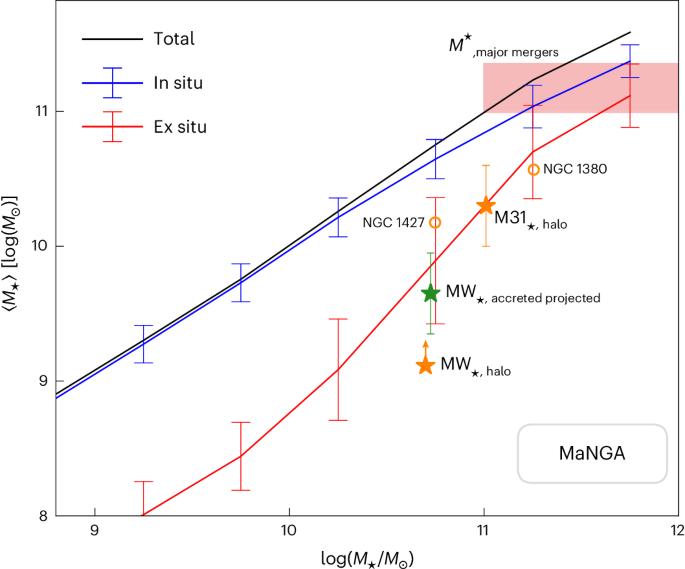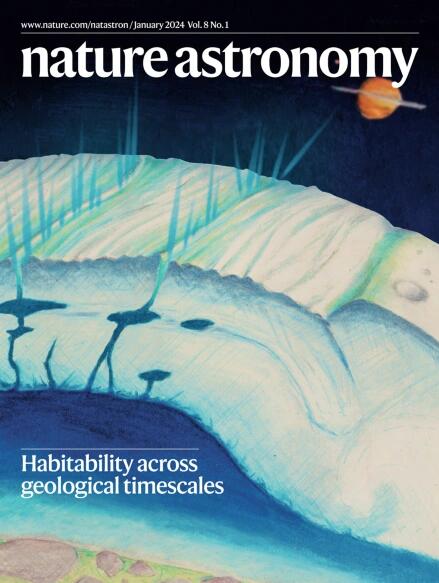利用人工智能获得的附近星系原位和非原位恒星质量的约束条件
IF 12.9
1区 物理与天体物理
Q1 ASTRONOMY & ASTROPHYSICS
引用次数: 0
摘要
星系演化的层次模型表明,星系合并对驱动星系内恒星组装的复杂过程有重大影响。然而,精确测量吸积对星系恒星总质量的贡献及其与原地恒星形成的平衡是一个长期的挑战,因为它既不能直接观测,也不容易从观测特性中推断出来。利用来自 MaNGA 的数据,我们提出了一个具有统计意义的邻近星系样本中源于合并的恒星质量比例的理论依据预测。我们利用从宇宙学模拟(TNG50)中获得的模拟MaNGA类似物(MaNGIA)训练出的强大机器学习模型,揭示了原位恒星质量几乎在整个恒星质量谱(109 M⊙ < M⋆ < 1012 M⊙)中都占主导地位。只有在质量更大的星系(M⋆ > 1011 M⊙)中,吸积质量才成为一个重要的贡献者,最高可达恒星总质量的35-40%。值得注意的是,附近宇宙中的原地恒星质量与星系特征有明显的相关性,椭圆星系、淬火星系、慢速旋转星系以及位于大质量暗物质晕中心的星系的吸积质量较高。本文章由计算机程序翻译,如有差异,请以英文原文为准。


Constraints on the in situ and ex situ stellar masses in nearby galaxies obtained with artificial intelligence
The hierarchical model of galaxy evolution suggests that mergers have a substantial impact on the intricate processes that drive stellar assembly within a galaxy. However, accurately measuring the contribution of accretion to a galaxy’s total stellar mass and its balance with in situ star formation poses a persistent challenge, as it is neither directly observable nor easily inferred from observational properties. Using data from MaNGA, we present theory-motivated predictions for the fraction of stellar mass originating from mergers in a statistically significant sample of nearby galaxies. Employing a robust machine learning model trained on mock MaNGA analogues (MaNGIA) obtained from a cosmological simulation (TNG50), we unveil that in situ stellar mass dominates almost across the entire stellar mass spectrum (109 M⊙ < M⋆ < 1012 M⊙). Only in more massive galaxies (M⋆ > 1011 M⊙) does accreted mass become a substantial contributor, reaching up to 35–40% of the total stellar mass. Notably, the ex situ stellar mass in the nearby Universe exhibits notable dependence on galaxy characteristics, with higher accreted fractions favoured being by elliptical, quenched galaxies and slow rotators, as well as galaxies at the centre of more massive dark matter haloes. The contribution of accreted stars to a galaxy’s total stellar mass is hard to determine directly from observations. Here constraints are placed on the ex situ stellar mass for ~10,000 galaxies using a cosmological simulation and machine learning.
求助全文
通过发布文献求助,成功后即可免费获取论文全文。
去求助
来源期刊

Nature Astronomy
Physics and Astronomy-Astronomy and Astrophysics
CiteScore
19.50
自引率
2.80%
发文量
252
期刊介绍:
Nature Astronomy, the oldest science, has played a significant role in the history of Nature. Throughout the years, pioneering discoveries such as the first quasar, exoplanet, and understanding of spiral nebulae have been reported in the journal. With the introduction of Nature Astronomy, the field now receives expanded coverage, welcoming research in astronomy, astrophysics, and planetary science. The primary objective is to encourage closer collaboration among researchers in these related areas.
Similar to other journals under the Nature brand, Nature Astronomy boasts a devoted team of professional editors, ensuring fairness and rigorous peer-review processes. The journal maintains high standards in copy-editing and production, ensuring timely publication and editorial independence.
In addition to original research, Nature Astronomy publishes a wide range of content, including Comments, Reviews, News and Views, Features, and Correspondence. This diverse collection covers various disciplines within astronomy and includes contributions from a diverse range of voices.
 求助内容:
求助内容: 应助结果提醒方式:
应助结果提醒方式:


